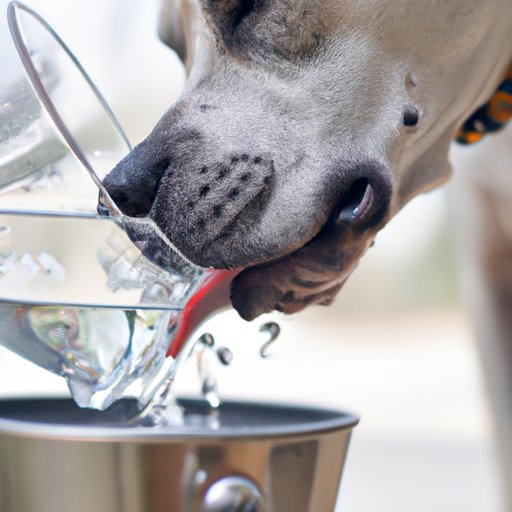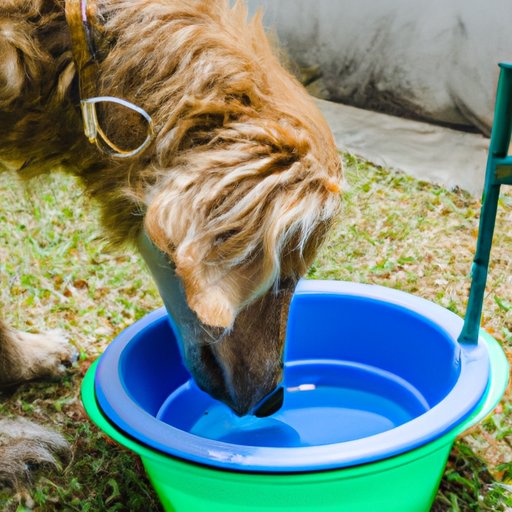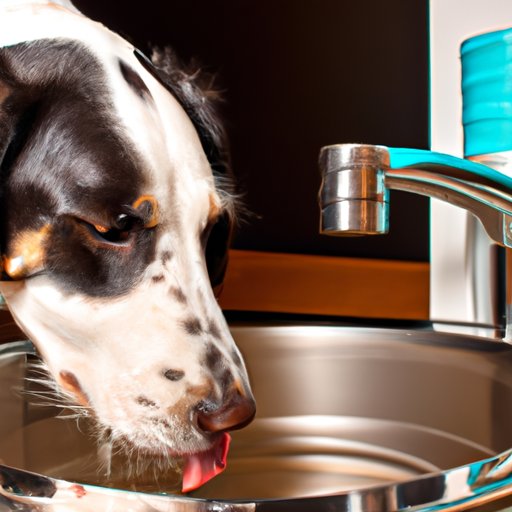Introduction
Well water is groundwater that has been extracted from an underground aquifer. It is typically used as a source of drinking water in rural areas where public municipal water sources are not available. If you live in an area where well water is the only option, you may be wondering if it is safe for your canine companion to drink. In this article, we will explore the pros and cons of letting your dog drink well water, how to assess if it is safe, what contaminants to look out for, and tips on creating a safe water supply from a well.

The Pros and Cons of Letting Your Dog Drink Well Water
Before deciding whether or not to let your dog drink well water, it is important to consider the pros and cons of doing so.
Pros
There are several advantages to letting your dog drink well water:
- Cost-Effective: Well water is often much cheaper than purchasing bottled water or having it delivered. This makes it an attractive option for budget-minded pet owners.
- Easily Accessible: For those who live in rural areas, well water is usually readily available and easy to access.
- Natural Source: Well water is a natural source of drinking water, which means it doesn’t contain the chemicals and additives found in many municipal water supplies.
Cons
However, there are also some potential drawbacks to letting your dog drink well water:
- Contamination Risk: Well water can be contaminated with a variety of pathogens, such as bacteria and viruses, as well as chemical pollutants.
- Unregulated Quality: Well water is not regulated by the government, so its quality can vary greatly from one location to another.
- Unknown Chemical Composition: The chemical composition of well water can vary depending on the surrounding environment, making it difficult to determine if it is safe to drink.

How to Assess if Well Water is Safe for Dogs to Drink
If you decide to let your dog drink well water, it is important to make sure it is safe. Here are some steps you can take to assess the safety of your well water:
Have the Water Tested
The best way to determine if your well water is safe for your dog to drink is to have it tested. Most local health departments offer free or low-cost water testing services. These tests will check for bacteria, viruses, and other contaminants that could be present in the water.
Look for Signs of Contamination
Even if you do not have your water tested, there are some signs you can look for that may indicate contamination. These include:
- Color: If the water has a strange color, such as yellow, orange, or red, it may be contaminated.
- Odor: If the water has a strong odor, such as sulfur or chlorine, it may be contaminated.
- Turbidity: If the water is cloudy or murky, it may be contaminated.
What Contaminants to Look Out For in Well Water Before Letting Your Dog Drink it
When assessing the safety of well water, it is important to be aware of the various contaminants that could be present. Here are some of the most common contaminants to look out for:
Bacterial Contaminants
Bacterial contaminants, such as E. coli, Salmonella, and Shigella, can cause gastrointestinal illness in both humans and animals.
Chemical Contaminants
Chemical contaminants, such as pesticides, nitrates, and heavy metals, can have a range of adverse health effects.

What to Do if Your Dog Drinks Well Water that Contains Contaminants
If your dog drinks well water that contains contaminants, it is important to take action quickly to minimize the risk of illness. Here are some steps you can take:
- Seek Veterinary Advice: Contact your veterinarian as soon as possible to discuss any symptoms your dog may be experiencing and to determine if any treatment is necessary.
- Monitor Symptoms: Be sure to monitor your dog closely for any signs of illness, such as vomiting or diarrhea.
- Provide an Alternative Water Source: Provide your dog with an alternative water source, such as bottled or filtered water, until the well water has been tested and deemed safe.
Tips on Creating a Safe Water Supply for Your Dog from a Well
If you decide to let your dog drink well water, there are some steps you can take to ensure it is as safe as possible. Here are some tips:
- Test the Water Regularly: Have your well water tested at least once a year to check for any contaminants.
- Install a Filtration System: Install a filtration system to remove any particles or contaminants from the water.
- Use a Water Softener: Use a water softener to reduce the amount of minerals and metals in the water.
Conclusion
In conclusion, while there are some benefits to letting your dog drink well water, there are also some risks. It is important to assess the safety of the water before allowing your canine companion to drink it. Be sure to test the water regularly, install a filtration system, and use a water softener to help ensure a safe water supply for your pup.
Summary of Main Points
This article explored the pros and cons of letting your dog drink well water, how to assess if it is safe, what contaminants to look out for, and tips on creating a safe water supply from a well. It is important to assess the safety of the water before allowing your canine companion to drink it. Be sure to test the water regularly, install a filtration system, and use a water softener to help ensure a safe water supply for your pup.
Final Reminders
Before letting your dog drink well water, it is important to consider the pros and cons of doing so. Have the water tested, look for signs of contamination, and be aware of the various contaminants that could be present. If your dog drinks well water that contains contaminants, seek veterinary advice, monitor symptoms, and provide an alternative water source. Finally, test the water regularly, install a filtration system, and use a water softener to help ensure a safe water supply for your pup.
(Note: Is this article not meeting your expectations? Do you have knowledge or insights to share? Unlock new opportunities and expand your reach by joining our authors team. Click Registration to join us and share your expertise with our readers.)
